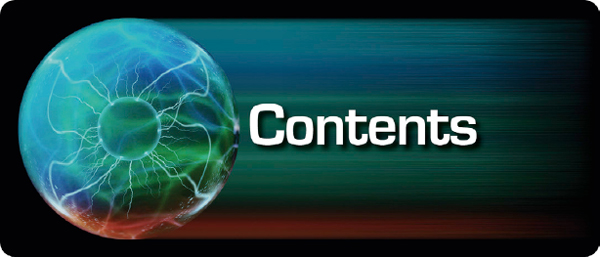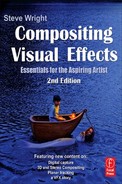
1.1 Digital Compositing with CGI
1.2 Compositing Visual Effects
2.1 Structure of Digital Images
2.2 Attributes of Digital Images
2.3.1 Photographic Images vs. Graphics
2.3.2 Indexed Color Images (CLUT)
3.2.1 Diffuse and Specular Passes
3.2.2 Occlusion and Shadow Passes
3.7 Working with Premultiplied CGI
3.7.2 Transformations and Filters
3.8.1 The 3D Compositing Environment
3.8.2 Placing 3D in Live Action
3.8.3 Placing Live Action in 3D
4.2.4 Scaling the Foreground and Background
4.3.2 Procedural Garbage Mattes
4.4 Compositing Outside the Keyer
4.5 Shooting Bluescreens (and Greenscreens)
4.5.4 Bluescreen vs. Greenscreen
5.1 Key, Matte, Alpha, and Mask
5.4.2 The Color Difference Mask
7.9 Adobe Photoshop Blending Modes
7.10.1 Skip Print/Frame Duplication
8.9.1 How Planar Tracking Works
8.9.2 What Planar Tracking is Used for
9.1.1 The Black and White Points
9.1.5 Pre-balancing the Color Channels
11.1 SDTV (Standard Definition Television)
11.1.1 Coping with Interlaced Video
11.1.2 Coping with Non-square Pixels
11.1.3 Coping with Color Sub-sampling
11.1.4 Coping with Edge Enhancement
11.1.5 Coping with Frame Rates
11.2 HDTV (High Definition Television)
12.1 Capture vs. Display Formats
12.2 Academy and Full Aperture
12.13 The Digital Intermediate Process
13.3.2 HDR Images on LDR Displays
13.4.3 Working with Log Images
14.3.1 Prepping the Stereo Plates
14.3.2 Compositing Greenscreen Shots
14.4.1 The Rubber Sheet Method
14.4.3 The Semi-transparency Problem
15.2 Sylvia Binsfeld—Writer, Director, Producer
15.5 Nicholas Barnes—3D Generalist
